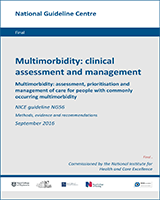From: 4, Methods

Multimorbidity: Assessment, Prioritisation and Management of Care for People with Commonly Occurring Multimorbidity.
NICE Guideline, No. 56.
National Guideline Centre (UK).
London: National Institute for Health and Care Excellence (NICE); 2016 Sep.
Copyright © National Institute for Health and Care Excellence, 2016.
NCBI Bookshelf. A service of the National Library of Medicine, National Institutes of Health.